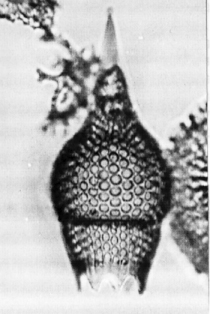 Calocycletta
(Calocyclopsis) serrata Moore
Calocycletta
(Calocyclopsis) serrata Moore Calocycletta
(Calocyclopsis) serrata Moore
Calocycletta
(Calocyclopsis) serrata MooreCalocycletta cf. virginis Haeckel, Riedel and Sanfilippo, 1970, p.568, pl.14, fig.11
Calocycletta serrata Moore, 1972, p.148, pl.2, figs.1-3
Cephalis ovate, lobed, with sparse circular to subcircular pores. Some pores extend from the cephalis up into the region of a stout, conical apical horn. Thorax subspherical to campanulate, with circular pores hexagonally arranged and tending toward longitudinal alignment. Slight lumbar stricture externally. Abdomen tapering distally and terminating in three to twelve triangular terminal feet. Feet varying greatly in length and may be irregularly spaced. Abdominal pores circular to subcircular, hexagonally arranged and longitudinally aligned. Longitudinal lines continuous with those of thorax (Moore, 1972).
Based on 30 specimens. Length of apical horn 72-110 µm, of cephalis 38-48 µm, of thorax 96-125 µm, of abdomen 43-96 µm, of feet 5-29 µm (Moore, 1972).
Similar to Calocycletta robusta, but with terminal feet fewer and obtusely rounded (Riedel and Sanfilippo, 1978a).
The broad, shovel-shaped feet distinguish Calocycletta serrata from C. robusta, C. virginis and C. caepa. Superficially similar members of the genus Podocyrtis are more spindle-shaped, with ridges separating longitudinal rows of pores (Sanfilippo et al., 1985).
The sparse pores on the cephalis vary in number, and in some specimens penetrate the base of the robust, cylindro-conical apical horn. The thorax is inflated-campanulate to subspherical, separated by the lumbar stricture (only slightly, if at all, expressed externally) from the short, tapering abdomen. Feet are shovel-shaped, 3-12 in number (Sanfilippo et al., 1985).
This short ranging species occurs sparsely in early early Miocene assemblages from the tropical parts of the ocean basins. Its morphotypic first appearance is approximately synchronous with the lower limit of the Cyrtocapsella tetrapera Zone and it becomes extinct within the same zone.
Because its range is so short, it is not present in the ODP shipboard set of radiolarian zonal slides.
This species apparently evolved from C. robusta at about the same time as the much commoner, longer ranging C. virginis.
For further taxonomic notes see Moore (1972).
Additional illustrations can be found in Dinkelman, 1973, pl.7, fig.5.
For generic level phylogeny see Sanfilippo and Riedel, 1992, p.30.